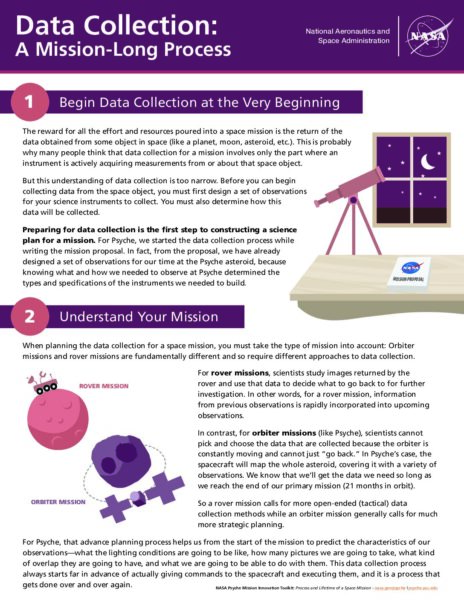NASA Data Collection
This NASA Data Collection Document explains the in-depth steps involved in the mission-long process of data collection. Steps include Initial data collection, understanding your mission, being prepared to redo everything, accepting and welcoming uncertainty, planning ahead extensively, integrating expertise, scheduling data downlinks, narrowing the target, gathering and cross-checking data, and finally, analyzing and archiving the data.
NASA establishes criteria for each NASA-sponsored payload. Four risk classification levels (A thru D) are defined in the NASA Procedural Requirements (NPR). For example:
Initial data collection
Preparing for data collection is the first step to constructing a science
plan for a mission. For Psyche, we started the data collection process while
writing the mission proposal. In fact, from the proposal, we have already
designed a set of observations for our time at the Psyche asteroid, because
knowing what and how we needed to observe at Psyche determined the
types and specifications of the instruments we needed to build.
Understanding your mission
When planning the data collection for a space mission, you must take the type of mission into account: Orbiter
missions and rover missions are fundamentally different and so require different approaches to data collection.
Be prepared to redo everything
If you’re the kind of person who likes to be finished with a task after completing it once,
then planning spacecraft observations will frustrate you! To plan spacecraft observations,
you must embrace the need to rethink, remodel, or redo a task when circumstances
change suddenly—even if you’ve already worked hard on it.
Accepting and welcoming uncertainty
While unexpected situations can occur during any mission, this method of pre-planning data collection may require
that you accept uncertainty as well as change.
For the Psyche Mission, we have embraced the fact that, due to the spacecraft’s use of electric propulsion, the
specific timing of the observations (in terms of where we are around the surface of Psyche) is going to remain
unknown until almost the last minute.
Planning ahead extensively
Even when there are uncertainties, it is still necessary to
plan for the conditions of data collection once we
arrive at a space object.
Integrating expertise
The Psyche team is comprised of smaller subgroups, each with specific tasks and expertise. Most groups are involved
in data collection in some way, particularly during active data collection at the asteroid.
Scheduling data downlinks
Once the spacecraft reaches orbit and starts collecting observations, we need a way to retrieve that data. Early
in the Psyche Mission, we will send commands to the spacecraft (“uplink”) about once a month. Using those
commands, the spacecraft will take images, or acquire other data, of the surface for a specified number of orbits,
and then it will send the data back (“downlink”).
Narrowing the target
Throughout the mission, we will be planning observations to assure that we collect enough data to make a complete
global map of the asteroid. Given the amount of coverage we’ll get in Orbits A, B, and C, we are confident that we
will record everything on the surface.
Gathering and cross-checking data
The specific data products (images or other types of data) that the spacecraft will send back have been planned
literally years in advance. But because of the uncertainties and the changes we have to deal with, we won’t know if
the commands we send to the spacecraft will actually give us what we want.
Analyzing and archiving the data.
Each image the spacecraft takes will be calibrated for
different color filters. Once we have our mosaics, we’ll be
able to apply these calibrations to the data. Then we’ll
distribute them to the science team.
Interested in learning more about NASA’s Psyche Mission?
The NASA Psyche Mission Innovation Toolkit includes a series of free online courses based on the real-world challenges and skills associated with the Psyche mission’s science, engineering, technology, and teamwork. Click below to learn more:


